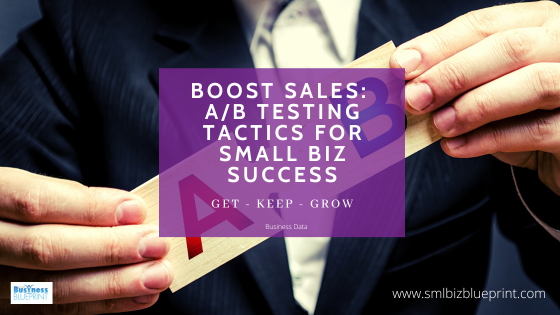A/B testing is the silent powerhouse behind some of the most successful small businesses today.
The practical compass guides big and small decisions towards more profitable shores.
By splitting your audience to test variant ‘A’ against ‘B,’ you gain more than just numbers; you learn about customer preferences, market trends, and the effectiveness of your communication.

Introduction to A/B Testing
In an online world inundated with data, A/B testing stands as a beacon of empirical decision-making.
By presenting two variants to a similar audience, businesses can single out strategies that lead to success with precision. For business owners vying for the digital space, A/B testing is not just an option; it’s an imperative move towards growth.
Actions
Start simple: Choose one aspect of your marketing campaign that you think could impact performance most and set up a basic A/B test focusing on that change.
Educate your team: Ensure everyone understands the value and mechanics of A/B testing. Use webinars, workshops, or educational content to bring them up to speed.
Prioritise clarity: Define objectives for your A/B test, such as increasing click-through rates or improving email open rates, to ensure you’re chasing tangible outcomes.
Sign up for our newsletter today.
The Importance of A/B Testing in Modern Marketing
Marketing is no longer just an art; it’s a science. As a business owner, you need to harness the power of A/B testing to fine-tune your marketing campaigns for precision targeting and optimal results.
A/B testing helps you understand what resonates with your audience, ensuring your marketing dollars are well spent.
Actions
Allocate budget: Dedicate a portion of your marketing budget to A/B testing to ensure you can run tests regularly and respond to results with action.
Embrace a testing culture: Encourage a company culture that values testing and learning from failures as much as successes.
Stay updated: Keep abreast of the latest A/B testing trends and tools by subscribing to marketing journals or online communities.
Setting Up Your A/B Test for Success
Proper A/B testing starts with a hypothesis. Whether it’s testing the colour of a call-to-action button or the subject line of an email, the clarity of your test design determines the quality of your insights.
Selecting measurable outcomes and using robust A/B testing tools are fundamental to obtaining reliable data.
Actions
Use technology: Invest in a reliable A/B testing platform to help you design tests, collect data, and analyse results accurately.
Test one variable at a time: To ensure your results are meaningful, change only one element per test.
Establish control and test groups: Make sure you have a control group (original version) and a test group (new version) to compare performance accurately.
Determining Data Points for Meaningful A/B Testing Results
In pursuing impactful A/B testing, the question of “How much data do I need?” often arises.
A/B testing’s cogency is deeply rooted in statistical significance—the probability that the results observed are due to the changes made rather than random chance.
Actions
Use a Sample Size Calculator: Before running an A/B test, determine the sample size needed for statistical significance. Online calculators can help estimate this figure by inputting your current conversion rate and the expected improvement rate.
Define Minimum Detectable Effect: Decide on the smallest change in conversion rate that would be meaningful for your business strategy. This definition guides the design of your A/B test and helps you understand whether the outcome of your test is significant enough to warrant business changes.
Be Patient for Valid Results: Allow your A/B test to run until it reaches the required sample size. Waiting for the data to mature is crucial for high-stakes decisions, which may require running the test for several weeks or months.

Adapting A/B Testing for Low-Traffic Sites
Low traffic can be a hurdle in collecting data swiftly. However, even low-traffic sites can derive robust insights from A/B testing with the right approach.
Actions
Extend Test Durations: If your website doesn’t receive high traffic, you may need to run your A/B test for an extended period. This longer duration compensates for the lower traffic by providing a larger data set over time.
Test Big Changes: Small tweaks may not produce significant data in situations where data is sparse. Instead, test major changes that can cause large shifts in user behaviour and conversion rates.
Focus on Key Conversion Points: Concentrate your testing on areas of your site with the most significant potential impact—such as your main product page or a well-trafficked landing page. Changes here can yield more pronounced results, offering insights more likely to translate into meaningful business outcomes.
Increasing the Quality of Insights with Low Volume
When the quantity of traffic is a limiting factor, emphasise the quality of the data and insights you gather.
Actions
Employ Qualitative Feedback: Supplement your quantitative data with qualitative insights. Utilise user surveys, interviews, and usability tests to understand why users prefer one variant over another.
Leverage External Research: Look for industry benchmarks and case studies that can provide context for your A/B tests. While your own data is most relevant, external research can offer additional insights and validate your findings.
Segment Your Results: Break down your A/B test results by demographics or user behaviours. This segmentation can reveal valuable patterns and preferences within specific user groups, even with low overall volume.
Deciding What to Test
For effective A/B testing, focus on elements that promise the highest conversion uplift. Test variables like page layout, promotional offers, or checkout process steps.
Even a change as simple as the wording on a landing page can significantly affect customer behaviour.
Actions
Identify high-impact elements: Prioritize testing elements on your website or your marketing material that directly contribute to conversion, such as headlines or images.
Seek customer feedback: Use surveys or feedback tools to understand what customers like or dislike about your current offerings to inform what to test.
Competitive analysis: Look at competitors’ actions and test those variables to see if they could work for your business.
Interpreting A/B Testing Results
The goal of analysing A/B testing is not just to declare a winner but to understand why one variant outperformed another. By analysing your A/B test results, you can make changes that lead to a better user experience and increased revenue.
Actions
Set a timeframe: Decide on a testing period long enough to gather sufficient data but short enough to act on the findings promptly.
Look beyond the ‘winning’ option: Analyze why an option performed better and understand the underlying user behaviour.
Test repeatedly: Even if you find a winning element, retest it against new variations to optimise further.
Have you seen an improvement in your campaigns from A/B testing? Share your story with us!

Common Pitfalls in A/B Testing and How to Avoid Them
Missteps in A/B testing can skew results, leading to misguided decisions. Avoid common errors like testing too many variables at once or basing decisions on incomplete data.
By knowing these pitfalls, you ensure your tests yield actionable findings.
Actions
Avoid duration mismatch: Run the test for an adequate time to account for variability in traffic and conversions.
Control for external factors: Be aware of events like holidays or sales that might skew your test results, and plan accordingly.
Use clear success metrics: Decide on the key performance indicators (KPIs) you will use to measure the success of your test beforehand to avoid any confusion after the test is completed.
Advanced A/B Testing Tactics
Once you’ve mastered the basics, consider advanced tactics like multivariate testing or predictive analytics. These approaches can uncover deeper insights and further optimise your campaigns.
Actions
Segment your audience: Use customer segmentation to run more targeted A/B tests within different customer groups.
Explore multivariate testing: Once comfortable with A/B tests, consider multivariate testing to see how multiple variables interact.
Continuous learning: Make A/B testing a regular part of your strategy, learning and iterating as you gather more data.
Integrating A/B Testing with Other Data-Driven Techniques
A/B testing is most powerful when combined with other data-driven marketing practices. Use it alongside customer segmentation, personalisation, and analytics to not just guess but know what your audience wants.
Actions
Combine with analytics: Use web analytics to find areas with high drop-off rates that might benefit from A/B testing.
Personalisation: Use the results from A/B tests to drive personalised experiences for different user segments.
Cross-channel testing: Don’t limit A/B testing to one channel; apply learnings across different platforms for a cohesive strategy.
Taking Action on Test Insights
Turn insights into action. The real value of A/B testing comes from implementing the lessons learned. It’s an ongoing process of refinement that keeps your marketing efforts at the forefront of efficiency and effectiveness.
Actions
Implement changes: Act on your A/B test results data to make informed campaign changes.
Communicate results: Share insights from A/B tests with your team to inform broader marketing strategies and decisions.
Plan next tests: Based on what you’ve learned, plan your next set of A/B tests to continue optimising your campaigns.

Must Haves
Define Clear and Measurable Objectives:
Before starting an A/B test, defining what success looks like is crucial. Set specific, measurable goals to determine whether the changes you’re testing are effective. This could be increasing the click-through rate on a call-to-action button or improving the conversion rate on a landing page.
Ensure Statistical Relevance:
To trust the results of your A/B test, you must collect enough data to achieve statistical significance. This means running the test until you have a sufficient sample size to make a confident decision, which could sometimes require a longer test duration, especially for low-traffic sites.
Test Iteratively and Learn from Each Test:
A/B testing is not a one-off event but a continuous learning and improvement process. After analysing the results of each test, apply the insights to implement changes, and then plan your next test. You can incrementally improve the user experience and your business’s performance by continuously refining your approach based on test outcomes.
Additional Options
Leverage Loss Aversion:
Traditional A/B testing focuses on positive gains like improving clicks or conversions, but considering what users want to avoid can be equally enlightening. Testing copy or design changes that emphasise the prevention of loss or inconvenience can tap into the psychological principle of loss aversion, where the pain of losing is more potent than the pleasure of gaining something of equivalent value.
Utilise Weather or Seasonality:
While seemingly unrelated to digital campaigns, integrating weather data or seasonality into your A/B testing can uncover unique customer behaviour patterns. For instance, testing different product recommendations or ad copy that aligns with seasonal changes, holidays, or weather patterns in the user’s locale can provide insightful data on temporal consumer preferences.
Test for Emotional Engagement:
Going beyond conventional metrics like clicks and conversions, consider using tools that measure users’ emotional engagement with content. This can include analysing scroll depth on a page, using heatmaps to see where users linger, or even testing different emotional triggers in imagery and language to see which variants create a more engaged (longer site visits, more thorough reads) user experience.
Starting Your A/B Testing Journey
Remember, the path to improved conversion rates and higher customer satisfaction begins with one test. Start your A/B testing journey today and embrace the continuous improvement that data-driven marketing offers.
FAQs
Q1: What exactly is A/B testing, and why is it important?
A1: A/B testing is a method to compare two versions of a web page or app against each other to determine which one performs better. It’s important because it allows businesses to make data-driven decisions and optimise their digital properties based on user behaviour.
Q2: How do I set up an A/B test?
A2: To set up an A/B test, you should:
- Identify the goal of your test.
- Choose the variable you want to test.
- Create two versions of your content: the control version (A) and the variation (B).
- Split your audience randomly and serve each group one version of the content.
- Collect and analyse the results to see which version meets your goal more effectively.
- What elements should I test in my marketing campaigns?
You can test virtually any element that you believe will influence user behaviour. Common elements include headlines, call-to-action buttons, images, product descriptions, emails, and overall layout. Choose elements that are closely tied to your test’s objectives.
Q3: How can I interpret the results from an A/B test?
A3: Interpretation involves analysing the collected data to see which version better achieved the set goal. Look at key metrics like conversion, click-through, and engagement levels. Use statistical analysis to determine if the results are significant and not due to chance.
Q4: What are some common mistakes in A/B testing?
A4: Common mistakes include changing multiple elements at once, not running the test long enough to gather sufficient data, and not accounting for external factors that could affect the results. Another mistake is acting on results without ensuring they are statistically significant.
Q5: Can you give examples of successful A/B tests?
A5: Successful A/B tests often involve simple changes with significant impacts, such as changing the colour of a ‘Buy Now’ button, which leads to a measurable increase in purchases, or altering the wording of a signup prompt, resulting in a higher subscription rate.
Q6: How does A/B testing fit into a broader marketing strategy?
A6: A/B testing fits into a broader marketing strategy as a continuous improvement tool. It works alongside other market research, analytics, and user feedback methods to refine marketing approaches and enhance user experience, leading to better campaign performance and ROI.
Conclusion
In conclusion, A/B testing is the key to unlocking the potential of your marketing campaigns.
By applying the insights from the data, you enhance your campaign’s effectiveness and ensure that every decision is justified with evidence. Now is the time to act on the data and supercharge your marketing efforts.




